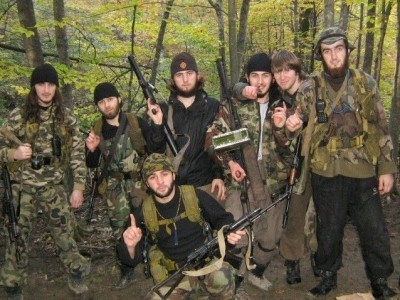
Will Crimea Become Russia’s New Chechnya?
Publication: Eurasia Daily Monitor Volume: 11 Issue: 49
By:

With tensions rising around the Ukrainian peninsula of Crimea, observers are increasingly drawing parallels to Chechnya. Crimea is an autonomous region within Ukraine—as Chechnya is within Russia—and has peculiarities that are likely to resonate in the future.
The Russian Empire carved the Crimean Khanate out of the Ottoman Empire during the reign of Catherine the Great. The first military conflict between the Russian and Ottoman empires, which lasted from 1768 to 1774, ended with a Russian victory and the signing on July 21, 1774, of the Treaty of Kucuk Kaynarca, under which the Ottoman Empire recognized the independence of the Crimean Khanate. The Ottomans’ attempt to reconquer Crimea during the war of 1789–1791 ended in another defeat for them and the Treaty of Jassy, which was signed on January 9, 1792, and confirmed Russia’s rights over Crimea and the Kuban region (www.spsl.nsc.ru/history/descr/krym.htm).
Crimea remained part of the Russian Empire for 125 years, but in 1954, Soviet leader Nikita Khrushchev handed the peninsula over to the Ukrainian Soviet Socialist Republic (SSR), since all connections with this territory passed through Ukrainian territory. Among the many explanations of why Crimea was handed over to Ukraine, the most plausible one is that the central government in Moscow wanted to reconstruct Crimea at the expense of the relatively rich Ukrainian SSR (https://sevastopol-ua.info/peredacha-Kryma.php).
However, the problems of Crimea were very specific. The Crimean Tatars, numbering 200,000 people, who had inhabited the peninsula since the 13th century, were deported en masse to Central Asia by Joseph Stalin in 1944 for alleged collaboration with the Nazis (V. A. Berdinskikh, Spetsposelentsy: Politicheskaya ssylka narodov Sovetskoi Rossii [Special Settlers: Political Exile of People of Soviet Russia], Moscow, 2005). In actuality, the Crimean Tatars collaborated with the Germans to no greater extent than did the ethnic Russians or ethnic Ukrainians. Unlike other rehabilitated peoples, such as the Volga Germans, Chechens, Ingush, Balkars, Karachays and others, the Crimean Tatars were not allowed to return to their homes in Crimea in 1957. They were given this right only under Mikhail Gorbachev in 1989. However, upon their return, the Crimean Tatars encountered stiff resistance from the local population, which did not want to return property to its previous owners. This conflict forced Kyiv to establish direct control over the region in order to avoid destabilization. According to the last census, taken in 2001, out of Crimea’s total population of 2 million, the Tatars make up only 12 percent, while ethnic Russians account for 60 percent (https://2001.ukrcensus.gov.ua/rus/results/general/nationality/crimea/).
Even though the Crimean Tatars are now a minority in their historical homeland, they are politically united and recognize the authority of the structure set up by Crimean Tatar nationalists—the Mejlis (Parliament). They are a strong Muslim community with strong ties to Turkey (qtmm.org, accessed March 13).
The Crimean Tatars are active in politics and in the Islamic world. Hizb ut-Tahrir (the Party of Liberation), has strong positions among Crimean Tatars (www.rus-obr.ru/ru-web/26933). Crimea was one of the few places in the post-Soviet space where Muslims openly called in mosques and the streets for war on Bashar al-Assad in Syria (https://news2000.com.ua/news/sobytija/v-ukraine/231273).
Moreover, some Crimean Tatars set up their own battalion in Syria, which is fighting in the Aleppo area as part of the al-Muhajireen wal-Ansar brigade. Abdul-Kerim is the commander of this battalion (https://shamnews.tv/archives/389). This jamaat in Syria is becoming increasingly popular and the fact that Abdul-Kerim Krymsky (Crimean) is already the deputy of Salauddin, the commander of al-Muhajireen wal-Ansar, is telling. This union is not accidental. Chechens and Crimean Tatars sympathize with one another, based on their shared tragedy of deportation. This union may become an important factor as Crimean Tatars make political demands, such as reparations for the 1944 deportation, return of their historical villages and cities and affirming their native (titular) status on the peninsula.
Crimean Tatars realize perfectly well that if Crimea joins Russia, all of their demands will remain unmet, so they are a strategic ally of the small Ukrainian population of Crimea, who account for 24 percent of the total population there.
The Crimean Tatars resemble Chechens not only in terms of being politically active, but also by the fact that the Russian military is deploying commanders to Crimea who were commanders in Chechnya. For example, Lieutenant General Igor Nikolaevich Turchenyuk is the commander of the Russian occupation forces in Crimea. In Chechnya, Turchenyuk commanded the 138th Motorized Rifle Brigade in the Zapad group, which was under the command of Vladimir Shamanov in Chechnya (https://www.kavkaz-uzel.ru/articles/239329/). This “hero” of the Russian-Chechen war is accused by human rights activists of mass killings of Chechen civilians in 1999–2000 in Chechnya (https://echo.msk.ru/blog/shalommani/1276868-echo/).
Moreover, military personnel and ammunition is being dispatched to Crimea from the North Caucasus, in particular, from Chechnya and Dagestan (https://adygeia.kavkaz-uzel.ru/articles/239182/). The Russians believe the deployment of Chechens to Crimea could neutralize the Crimean Tatars—the thinking being that the Crimean Tatars would be unwilling to come into conflict with the Chechens.
The Chechen Republic’s head, Ramzan Kadyrov, stated that he was prepared to dispatch troops to Crimea to protect Russian interests (www.youtube.com/watch?v=1thDqy5t8s0). As a counterbalance, some Chechens in Europe organized a campaign of volunteers to help the Ukrainians (www.chechenews.com/world-news/politics/16971-1.html).
So, Chechens may come into conflict with other Chechens over Ukraine, as they did in Syria. There would be Chechens in both camps—among the jihadists who would align with any Crimean Tatar jihadists that may come about, and among the European volunteers who would support the Ukrainian militants, all of whom could come into conflict with Chechens sent to enforce Moscow’s interests on the peninsula. Russia somehow manages to create problems for itself even in places where they should not exist.
Thus, with Crimea, Russian is creating a new hotbed of tensions that will become tightly connected to the jihadists of the North Caucasus. This will extend the conflict in the North Caucasus to Crimea, with all the consequences that entails for Moscow.




